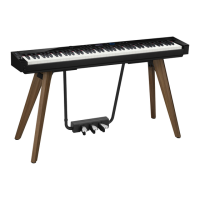Troubleshooting
EN-161
● The pedal has no effect.
● The sound does not become louder or softer depending on how I play (touch).
● The sound tone, effects, etc. do not change even after turning the power off and then back on
(the Digital Piano does not return to its initial default settings).
● When connected to a computer, MIDI cannot be sent or received.
● Some tones are the same but have slightly different sound quality and volume depending on
the keyboard position.
● When the buttons are pressed, the sound that is being played is temporarily interrupted or the
sound quality becomes slightly different.
Reason: a. The pedal cable is not properly plugged into the PEDAL UNIT or EXPRESSION/
ASSIGNABLE jack. Or the plug is incompletely plugged in.
b. The pedal type assignment or function assignment to the jack to which the pedal is
connected is incorrect.
Solution: a. Check that the pedal cable is properly connected and that the plug is firmly inserted
into the jack.
b. Change to the correct settings. See “EXPRESSION/ASSIGNABLE jack” (page
EN-63).
Reason: “Touch Response” (page EN-122) is set to “Off”.
Solution: Set “Touch Response” to a setting other than “Off”.
Reason: “Auto Resume” (page EN-17) is set to “On”.
Solution: Turn “Auto Resume” to “Off” and turn the power off and then back on.
Solution: a. Check that the Digital Piano is properly connected to the computer with a USB
cable and that the Digital Piano is correctly selected in the settings of the
computer’s music software.
b. Try turning off the Digital Piano and closing the music software on the computer,
then turn on the Digital Piano and restart the music software on the computer.
Reason: This is not a malfunction, but a result of an electronic process called digital sampling
*
.
* A process whereby several tone registers (low, mid, high, etc.) of the original
instrument are recorded to capture the sound quality in each of the original
instrument sound registers. The samples are then processed to create a single tone.
Reason: When using the Layer function, Duet function, song playback, or recording function,
multiple parts sound at the same time. Pressing the buttons in such cases will
automatically change the internal effect settings specific to the tone and may cause
this phenomenon to occur in some parts, but it is not a malfunction.

